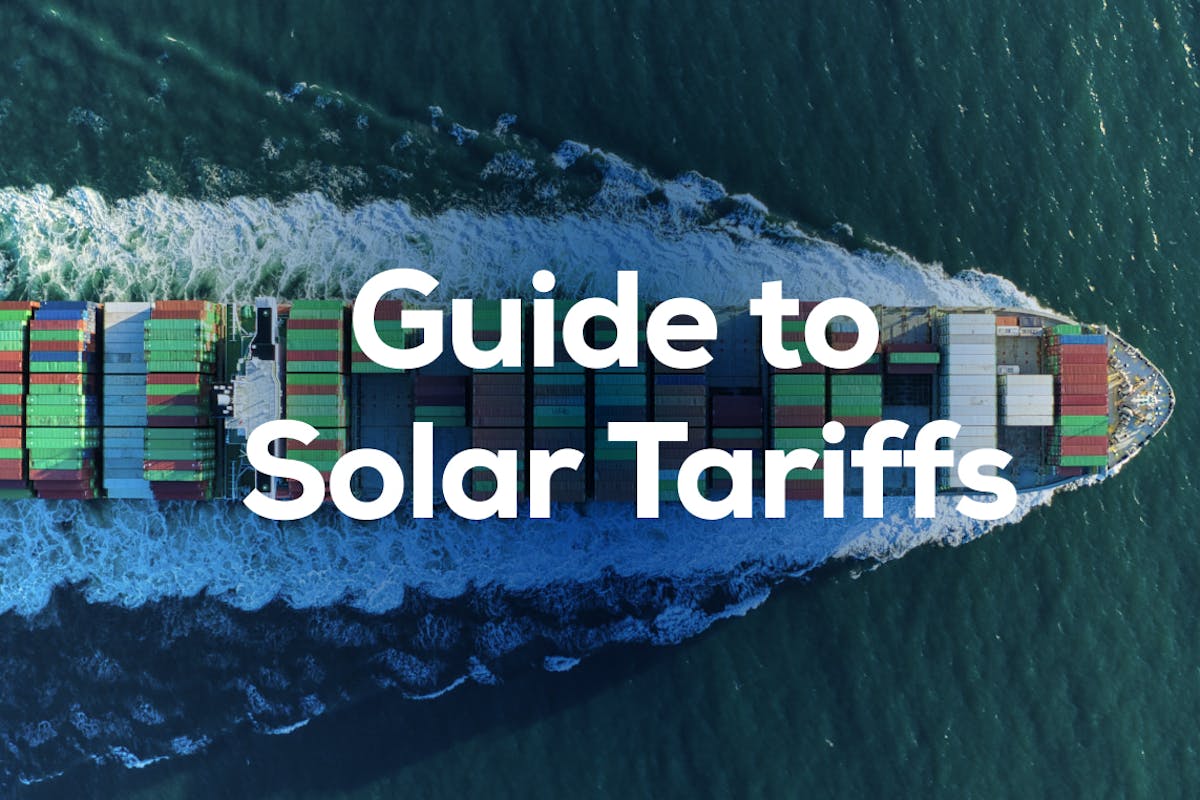Solar Tariffs (The Palmetto Guide)
Last edited

Author
Cory O'Brien
Senior Director - Growth Marketing

Editor
Ryan Barnett
SVP, Policy & New Market Development

Experts and politicians across the U.S. are split on whether solar tariffs are a good or bad thing for the country. Solar tariffs can boost domestic solar production, but they may do so at the expense of the larger solar industry. In this post, we'll explain what a solar tariff is, the pros and cons of solar tariffs, a timeline of recent solar tariffs, and why tariffs matter to the average homeowner who is interested in going solar.
See how much you can save by going solar with Palmetto
What Are Solar Tariffs?
A solar tariff is an additional fee or tax that a country charges on various types of solar power equipment imported into its borders by manufacturers that are based in another country. Often this is added to solar modules (panels), module components, and the raw materials needed to make modules, but it can include other components as well.
This tax increases the cost to the buyer, so the buyer is incentivized to buy from domestic producers instead, which don’t have to pay the tariff. Essentially, the goal of a solar tariff is to level the playing field for domestic and international producers of solar equipment, so they can compete on more than just having the lowest price.
In this post, we'll look at a class of tariffs known as antidumping and countervailing (AD/CVD) tariffs. They are designed to counteract the prices of imports that are deemed to be below the fair market rate, which some experts believe can damage domestic production.
- Dumping - When a foreign producer sells their solar products in the United States at a price that is lower than their cost of production.
- Countervailing - When a foreign government provides financial assistance or a subsidy to producers of solar equipment, benefiting the production, manufacturing, or exportation of goods. These subsidies can take the form of direct cash payments, tax breaks, loans at below-market rates, or other financial incentives.
What Are Tariffs In General?
A tariff (also called a “duty”) is a form of tax applied to goods that are imported into one country from another. Tariffs can reduce overall imports from foreign companies, and bolster sales from domestic suppliers.
Tariffs are an economic policy device that is often directed towards a particular country to achieve specific economic goals, typically the correcting of trade, pricing, or technology imbalances.
While they may be used to raise revenue, tariffs can also be punitive or protective. For example, a high tariff on a specific country can reduce imports from that country as a form of economic pressure.
What Is The Purpose of a Tariff on Solar Cells?
Because a solar cell tariff adds additional costs to any solar modules imported from another country, it makes buying cheaper solar modules from overseas less appealing than paying for a panel manufactured domestically.
If the solar cell tariff is high enough, domestic solar distributors can become competitive in the industry, while still adhering to strict labor standards and employing U.S. workers.
How Do Solar Tariffs Work?
The idea behind solar tariffs is that if the domestic solar industry can be financially competitive with foreign manufacturers, this lets them invest in future growth, sales can increase, and more jobs can be created. More jobs often lead to increased consumer spending, and a healthier domestic economy overall. Meanwhile, if people still decide to buy solar panels from other countries, the government makes additional revenue from the tariffs on those imports.
Based upon these benefits, the U.S. International Trade Commission (ITC) may make a recommendation to the President to pursue the use of solar tariffs on behalf of companies in the U.S. solar industry.
The ITC serves as an arbiter when companies argue that tariffs are needed. By hearing proposals and examining the market in question, it can ensure that companies don't weaponize tariffs merely to reduce competition, as doing so would needlessly drive up costs.
Why Don’t All Countries Use Solar Panel Tariffs?
There are downsides to consider when it comes to solar panel tariffs. One is immediately obvious: If cheaper goods are priced out of the market, it can force consumers to spend more. As prices rise, some interested solar adopters may be priced out of the market entirely. Those who do purchase solar panel systems for their homes may have less to spend elsewhere, which can cause other industries to suffer.
Solar tariffs can also be damaging to the economies of the countries they're imposed on. If the tariffs are too high, exports will slow significantly. Tariffs on goods that make up a large portion of a country's gross domestic product can harm the economy.
As with most things policy-related, solar tariffs involve trade-offs. The ITC must take all of these factors into account to see how the entire renewable energy industry could be affected by the impact of tariffs on solar panels and solar modules. These types of decisions are never cut and dry, and there's much debate on both sides about which is the best way to proceed.
Advantages of Solar Tariffs
The proponents of solar tariffs argue that they give the U.S. more time to build the capacity required to compete globally in the solar supply chain, and more fully supply the needs of domestic solar installations.
According to their logic, since China makes up such a large portion of the output of solar cells, manufacturers in other countries (including the U.S.) struggle to become profitable enough to build additional facilities and scale up production. They need help to catch up to China’s lead and bring clean energy independence home.
Those advocates also say that solar tariffs can be an effective way to boost domestic production of solar cells. To support this argument, they often use data from the effect of Section 201 solar panel tariffs, as the domestic solar industry has tripled since those tariffs have gone into effect. In addition, some foreign companies have opened up operations within the U.S. to avoid the tariffs, further boosting our domestic production capabilities.
Because China is accused of using forced labor and relies heavily on coal, proponents of tariffs say the punitive effect of tariffs is warranted. Mamun Rashid, the COO of Auxin Solar, went as far as saying that relying on building our energy grid from China would be a national security risk.
Disadvantages of Solar Tariffs
Opponents of the tariffs say that artificially raising the price of solar panels does more harm than good to the overall solar industry. They argue that the growth of U.S. solar manufacturing has come at the expense of the growth of U.S. solar installations, and higher penetration of solar technology into the marketplace.
U.S. solar panel manufacturers have seen some growth from their increased ability to remain competitive in the market. However, installers and other businesses that rely on purchasing inexpensive solar panels could be seeing slower growth because of increased costs.
For example, according to data from Greentech Media, U.S. solar prices could be nearly 30% lower without the tariffs. The price that U.S. homeowners pay for panels is approximately 79% higher than in major European markets, 75% higher than in Japan, and 85% higher than in China.
Although proponents argue that supporting tariffs puts economic pressure on China, one of the world's largest polluters, opponents make the opposite claim. They say that increasing the barrier to entry for solar and slowing the adoption of the technology does more harm to the environment than the good provided by any pressures put on China.
Solar tariffs can potentially reduce innovation. Opponents of tariffs say economic pressure on companies that want to survive often drives new and innovative approaches to a problem. An industry too reliant on being propped up by policy rather than value operates in a distorted market. Tariff protection can result in lowered incentives to invest in new approaches to changing market dynamics.
Unintended consequences of solar tariffs also present a problem, as countries often don't respond well to having additional fees placed on their economic productivity. Retaliatory tariffs could be levied on goods exported by U.S. manufacturers, and any resulting trade war could have negative effects on both countries. For example, there has been a sharp increase in retaliatory actions between the United States and China since 2018.
Timeline of Solar Tariffs in the U.S.
There are a few notable events in recent history that have led to our current solar tariff environment:
May 2017 - Solar cell manufacturers Suniva and SolarWorld petitioned the U.S. International Trade Commission (ITC) to impose a tariff on imported solar panels. Although most of the solar energy industry opposed the action, Suniva and SolarWorld argued that, without a tariff on solar cells, remaining United States solar manufacturers could go out of business.
The ITC found that cheap solar panel imports were causing injury to domestic solar manufacturers. It agreed with the proposals by Suniva and Solarworld, sending a recommendation to then-President Trump that action should be taken. The companies argued that unfair trade practices continue to make it impossible for American solar power system manufacturers to compete without tariffs.
January 2018 - Trump announced solar tariffs would be enacted against imports of crystalline silicon solar panels and solar cells. The tariff would last four years, and start at 30%, decreasing 5% each year. (25% in year two, 20% in year 3, etc.)
These tariffs were enacted under authority granted to the president via Section 201 of the Trade Act of 1974. In cases where domestic companies feel injured or threatened, the president can impose tariffs to provide temporary relief.
The structure of the current Section 201 tariffs has changed several times since 2018. From the beginning, there has been an exemption for 2.5-gigawatts of cells each year. In 2019, an exemption was added for bifacial solar cells, which increase the renewable energy capabilities of solar panels by being able to generate power from both the front and the back.
The Trump administration revoked this exclusion in 2020, and he also increased the tariff rate from 15% to 18%. However, in 2021, the U.S. Court of International Trade (CIT) struck down both changes.
February 2021 - President Biden extended the existing solar tariffs for another four years. That extension by the Biden administration included a few modifications:
- The tariff quota increased to 5 gigawatts of cells and modules
- Renewed the exemption of bifacial solar cells
- Lowered the tariff rate to 15%
June 2022 - President Biden announced a two-year tariff exemption on solar panels from Southeast Asia, in response to an inquiry by the Commerce Department into possible trade violations involving Chinese products that had slowed down the solar supply chain.
Solar Tariffs and the Solar Industry
Solar tariffs are an economic policy tool that governments can use to promote their domestic manufacturing industry. Because tariffs can have a large impact on the cost of solar installations, it may be helpful for solar customers to understand how they work, and what their potential ramifications are.
Experts are divided on whether these policies help or hurt domestic solar efforts as a whole. The health of the international solar industry must be considered to effectively fight climate change on a global level. If the current Section 201 tariffs bolster U.S. production at the expense of installations around the world, it could become a net negative for the climate as a whole.
Regardless of what happens with tariffs, installing a solar power system on your home remains a great way to lower your energy costs. If you'd like to learn more about how solar panels might look on your roof and how much you could save, try out our Free Solar Design and Savings Estimate Tool today.


